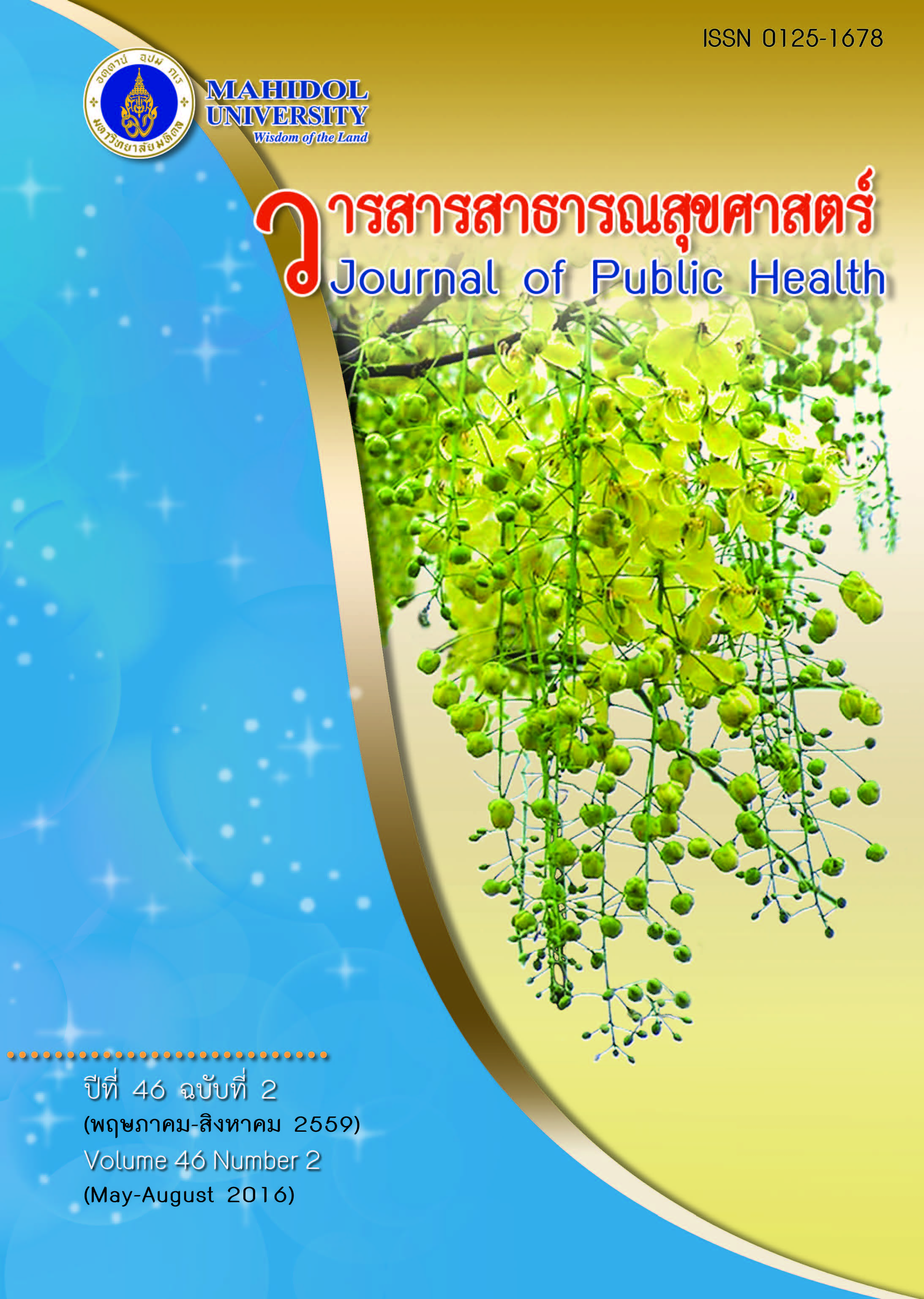การศึกษาแบบจำลองการเคลื่อนที่ของมวลอากาศแบบประมวลผลย้อนกลับเพื่อหาสาเหตุของการเปลี่ยนแปลงความเข้มข้นของมลพิษอากาศในประเทศจีน กรณีศึกษา: โอโซน
Keywords:
backward trajectories, HYSPLITmodel, มลพิษอากาศ, โอโซน, active fire, air pollution, OzoneAbstract
บทคัดย่อ
ประเทศจีนมีการพัฒนาทางด้านเศรษฐกิจอย่างรวดเร็วภายในระยะเวลา 30 ปีที่ผ่านมาส่งผลให้เกิดปัญหาการเพิ่มขึ้นของโอโซน (O3) จึงได้ทำการศึกษาปัจจัยที่มีผลต่อการเปลี่ยนแปลงของโอโซน โดยใช้แบบจำลอง HYSPLITเพื่อศึกษาลักษณะการเคลื่อนตัวของมวลอากาศในรูปแบบของการประมวลผลย้อนกลับย้อนหลัง10วันก่อนเข้าสู่พื้นที่ศึกษาในระหว่างปี ค.ศ.2004-ค.ศ.2007 ร่วมกับค่าความเข้มข้นของโอโซนจาก3 สถานี ได้แก่ ภูเขาไท้ (Mountain Tai) ภูเขาหัว (Mountain Hua) และภูเขาหวง (Mountain Huang) โดยแบ่งเป็น 9 กลุ่ม พบว่ามีการเคลื่อนตัวของมวลอากาศผ่าน 2 พื้นที่หลักคือกลุ่มลมที่พัดผ่านภาคพื้นทวีป ได้แก่กลุ่มที่ 7(W-NW)และ 8 (NW-N)และกลุ่มที่พัดผ่านมหาสมุทร ได้แก่ กลุ่มที่ 3 (E-SE), 4 (S-SW), 5(S-SW)และ 6 (SW-W)โดยกลุ่มที่พัดผ่านพื้นทวีปมีค่าความเข้มข้นของโอโซนสูงกว่ากลุ่มที่พัดผ่านมหาสมุทรส่วนกลุ่มลมที่พัดเข้าสู่พื้นที่ศึกษามากที่สุดคือกลุ่มลมที่ 7(W-NW)โดยค่าความเข้มข้นของโอโซนที่ได้รับอิทธิพลจากกลุ่มดังกล่าวเท่ากับ 51.2 ppb ในขณะที่กลุ่มลมที่ 3(E-SE)มีค่าต่ำสุดโดยมีค่าเฉลี่ยเท่ากับ 35.3 ppbผลการศึกษาแสดงให้เห็นว่ามวลอากาศที่เคลื่อนผ่านพื้นที่แตกต่างกัน โดยเฉพาะในพื้นที่ที่มีกิจกรรมของมนุษย์อย่างหนาแน่น เช่น พื้นที่ที่เกิด Active Fire จำนวนมากมีผลต่อความเข้มข้นของโอโซนในประเทศจีน ซึ่งการศึกษานี้สามารถนำมาประยุกต์ใช้เป็นแนวทางการเฝ้าระวังด้านอุตุนิยมวิทยา และความเข้มข้นของโอโซนในพื้นที่ที่จะได้รับอิทธิพลจากการเคลื่อนตัวของมวลอากาศล่วงหน้าให้กับประชาชนเพื่อเตรียมรับมือกับระดับของก๊าซโอโซนที่จะเพิ่มขึ้น โดยเฉพาะระบบการแจ้งเตือนประชาชนและกลุ่มเปราะบาง
Modeling of Backward Air Mass Trajectories to Identify Change of Air Pollution Concentration in China: Case Studies of Ozone (O3)
ABSTRACT
China has been one of the world economic leaders with rapid growth and social development for over 30 years. These have caused environmental pollution particularly air pollution in terms of ozone concentration changes. This study applied the “Backward Trajectories” method to determine the changes in ozone concentrations in China by emphasizing the origin of air masses and establishing a source-receptor relationship when air masses move across regions on a monthly basis, impacting ozone concentrations in China from 2004-2007. The Hybrid Single Particle Lagrangian Integrated Trajectory (HYSPLIT) Model was used to compute 10-day air mass transporting association with ozone concentration statistics recorded by 3 Air Quality Monitoring Stations in China, i.e., Mountain Tai, Mountain Hua and Mountain Huang. The results showed 2 air mass pathways through the study area, i.e., a continental air mass (7th cluster; W-NW, and 8th; NW-N) and an oceanic air mass (3rd cluster; E-SE, 4th; S-SW, 5th; S-SW, and 6th; SW-W). The ozone concentration was higher in the continental than the oceanic air mass. The 7th cluster was mostly found and average ozone concentration was 51.2 ppb, while the 3rd cluster was found to be associated with the lowest ozone concentration; 35.3 ppb. In addition, the air trajectories moving across areas where anthropogenic activities occur and active fire could potentially affect ozone concentrations in China. The findings of this research will benefit human health when a monitoring system of meteorological data and a warning system of health effect is launched and strictly implemented especially for vulnerable population groups.
Downloads
Published
Issue
Section
License
Creative Commons License CC-BY-ND


